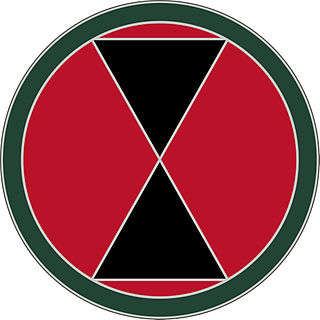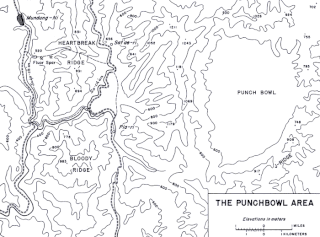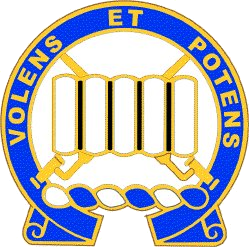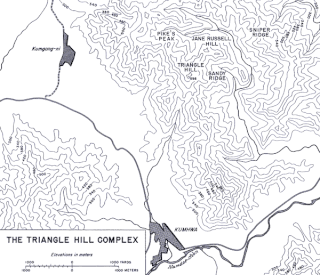Related Research Articles

The 2nd Infantry Division is a formation of the United States Army. Its current primary mission is the pre-emptive defense of South Korea in the event of an invasion from North Korea. There are approximately 17,000 soldiers in the 2nd Infantry Division, with 10,000 of them stationed in South Korea, accounting for about 35% of the United States Forces Korea personnel.
This is the Korean War order of battle. Subsidiary commands are listed on sub-pages. Where no date is shown for a command, assume it present at the start of the war, on June 25, 1950.

The 1st Cavalry Division is a combined arms division and is one of the most decorated combat divisions of the United States Army. It is based at Fort Hood, Texas. It was formed in 1921 and served during World War II, the Korean War, the Vietnam War, the Persian Gulf War, with the Stabilization Force in Bosnia-Herzegovina, in the Iraq War, in the War in Afghanistan and in Operation Freedom's Sentinel. As of October 2017, the 1st Cavalry Division is subordinate to III Corps and is commanded by Major General Jeffery D. Broadwater.

The 7th Infantry Division is an active duty infantry division of the United States Army based at Joint Base Lewis-McChord charged with sustaining the combat readiness of two Stryker brigade combat teams, a combat aviation brigade, a division artillery headquarters, and a National Guard Stryker brigade combat team, as well as participating in several yearly partnered exercises and operations in support of U.S. Army Pacific and the Indo-Pacific region. The 7th Infantry Division is the only active-duty multi-component division headquarters in the Army. The 7th Infantry Division is also home to two of the Army's newest enabling battlefield capabilities, the Multi Domain Task Force and the Intelligence, Information, Cyber, Electronic Warfare and Space Capabilities, or I2CEWS battalion.

Golden Gate National Cemetery is a United States national cemetery in California, located in the city of San Bruno, 12 miles (20 km) south of San Francisco. Because of the name and location, it is frequently confused with San Francisco National Cemetery, which dates to the 19th century and is in the Presidio of San Francisco, in view of the Golden Gate. Around 1937, San Francisco residents voted to bar the opening of new cemeteries within the city proper and, as a result, the site for the new national cemetery was selected south of the city limits in adjacent San Mateo County.

The Battle of Bloody Ridge was a ground combat battle that took place during the Korean War from 18 August to 5 September 1951.

Samuel Streit Coursen was a 1949 graduate of the United States Military Academy and company commander in the United States Army during the Korean War.

The 1st Infantry Division is a military formation of the Republic of Korea Army's I Corps. The division was established on 1947 under the command of Colonel Kim Suk-won.
The 19th Infantry Division was a military formation of the Korean People's Army.
The 43rd Infantry Division was a military formation of the Korean People's Army.
The II Corps is a corps of the Korean People's Army. It was created on June 12, 1950 with Lt. General Kim Kwang-hyop in command. During the Korean War the unit was composed of the 2nd Infantry Division, the 13th Mechanised Division, and the 27th Infantry Division.

The 7th Infantry Regiment is an infantry regiment in the United States Army. In its 200-year history it has participated in 12 wars, been awarded 78 campaign streamers, and 14 unit decorations. The regiment has served in more campaigns than any other infantry unit in the United States Army.

The Battle of Triangle Hill, also known as Operation Showdown or the Shangganling Campaign, was a protracted military engagement during the Korean War. The main combatants were two United Nations (UN) infantry divisions, with additional support from the United States Air Force, against elements of the Chinese People's Volunteer Army (PVA) 15th and 12th Corps. The battle was part of UN attempts to gain control of "The Iron Triangle", and took place from 14 October to 25 November 1952.

The Battle of Unsan, also known as the Battle of Yunshan, was a series of engagements of the Korean War that took place from 25 October to 4 November 1950 near Unsan, North Pyongan province in present-day North Korea. As part of the People's Republic of China's First Phase Campaign, the People's Volunteer Army (PVA) made repeated attacks against the Republic of Korea Army (ROK) 1st Infantry Division near Unsan beginning on 25 October, in an attempt to take advancing United Nations forces by surprise. In an accidental first encounter with the United States military during the Korean War, the PVA 39th Corps attacked the unprepared US 8th Cavalry Regiment in Unsan on 1 November, resulting in one of the most devastating US losses of the Korean War.

The Battle of the Ch'ongch'on River, also known as the Battle of the Ch'ongch'on, was a decisive battle in the Korean War, and it took place from November 25 to December 2, 1950, along the Ch'ongch'on River Valley in the northwestern part of North Korea. In response to the successful Chinese First Phase Campaign against the United Nations (UN) forces, General Douglas MacArthur launched the Home-by-Christmas Offensive to expel the Chinese forces from Korea and to end the war. Anticipating this reaction, the Chinese People's Volunteer Army (PVA) Commander Peng Dehuai planned a counteroffensive, dubbed the "Second Phase Campaign", against the advancing UN forces.

The Third Battle of Seoul, also known as the Chinese New Year's Offensive, the January–Fourth Retreat or the Third Phase Campaign Western Sector, was a battle of the Korean War, which took place from December 31, 1950, to January 7, 1951, around the South Korean capital of Seoul. In the aftermath of the major Chinese People's Volunteer Army (PVA) victory at the Battle of the Ch'ongch'on River, the United Nations Command (UN) started to contemplate the possibility of evacuation from the Korean Peninsula. Chinese Communist Party chairman Mao Zedong ordered the Chinese People's Volunteer Army to cross the 38th Parallel in an effort to pressure the UN forces to withdraw from South Korea.
The III Corps is a corps of the Korean People's Army. It was created just before the North Korean invasion of 1950 with Lt. General Yu Kyong-su in command. During the initial North Korean invasion of the south, it was in reserve, comprising the 10th Infantry Division, the 13th Division, and the 15th Infantry Division.

The 224th Infantry Regiment was a regiment of the United States Army. It was formed in 1946 from the 3rd Battalion of the 185th Infantry of the California National Guard. The regiment was part of the 40th Infantry Division during wartime and a unit of the California National Guard during peacetime.

The Battle of Pyongyang was one of the major battles of the United Nations' offensive during the Korean War. Following the Battle of Inchon, the UN forces re-captured Seoul, the capital of South Korea, and proceeded to advance into North Korea. Shortly after advancing, the American and South Korean forces faced the North Korean defenses near Pyongyang, the capital of North Korea, on 17 October.
The UN offensive into North Korea was a large-scale offensive in late 1950 by United Nations (UN) forces against North Korean forces.
References
- ↑ Gammons, Stephen L.Y. The Korean War: The UN Offensive. United States Army Center of Military History. CMH Pub 19-7. Archived from the original on 2010-06-12.
- ↑ Gordon L. Rottman, 'Korean War Order of Battle: United States, United Nations, and Communist Ground, Air, and Naval Forces 1950-1953,' Greenwood Publishing Group, 2002, 167.
| This article about a specific military unit is a stub. You can help Wikipedia by expanding it. |